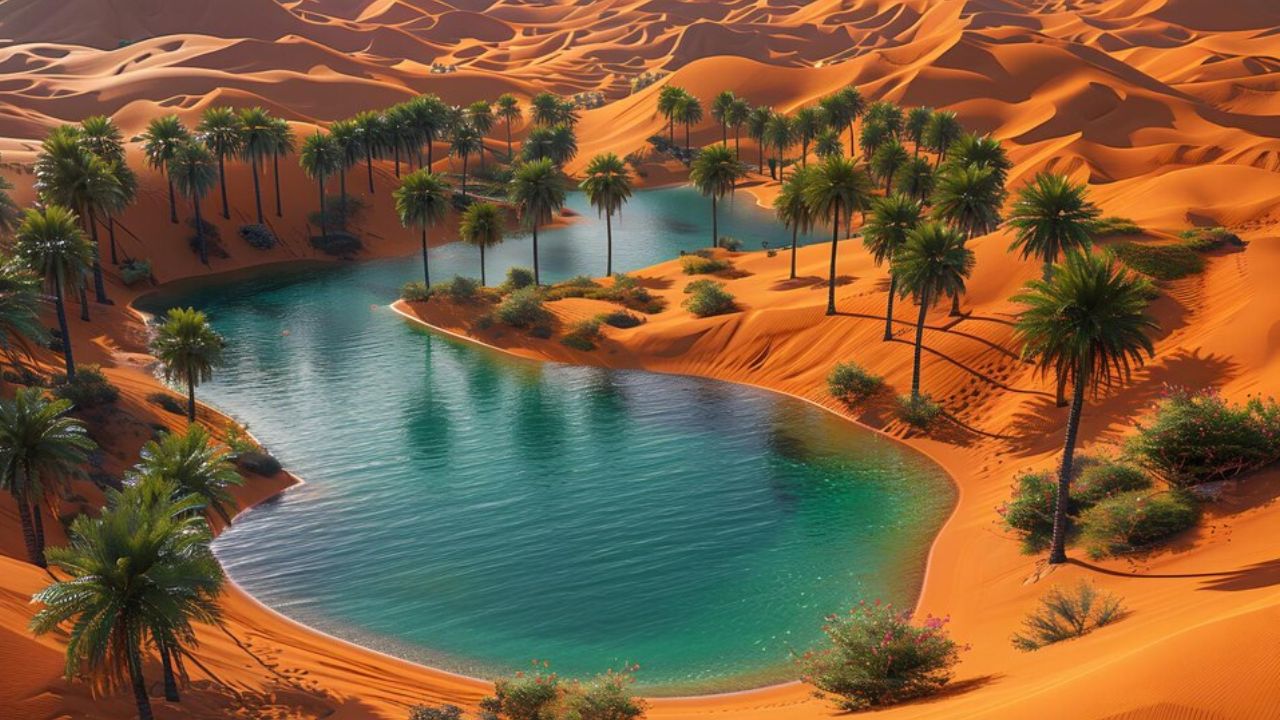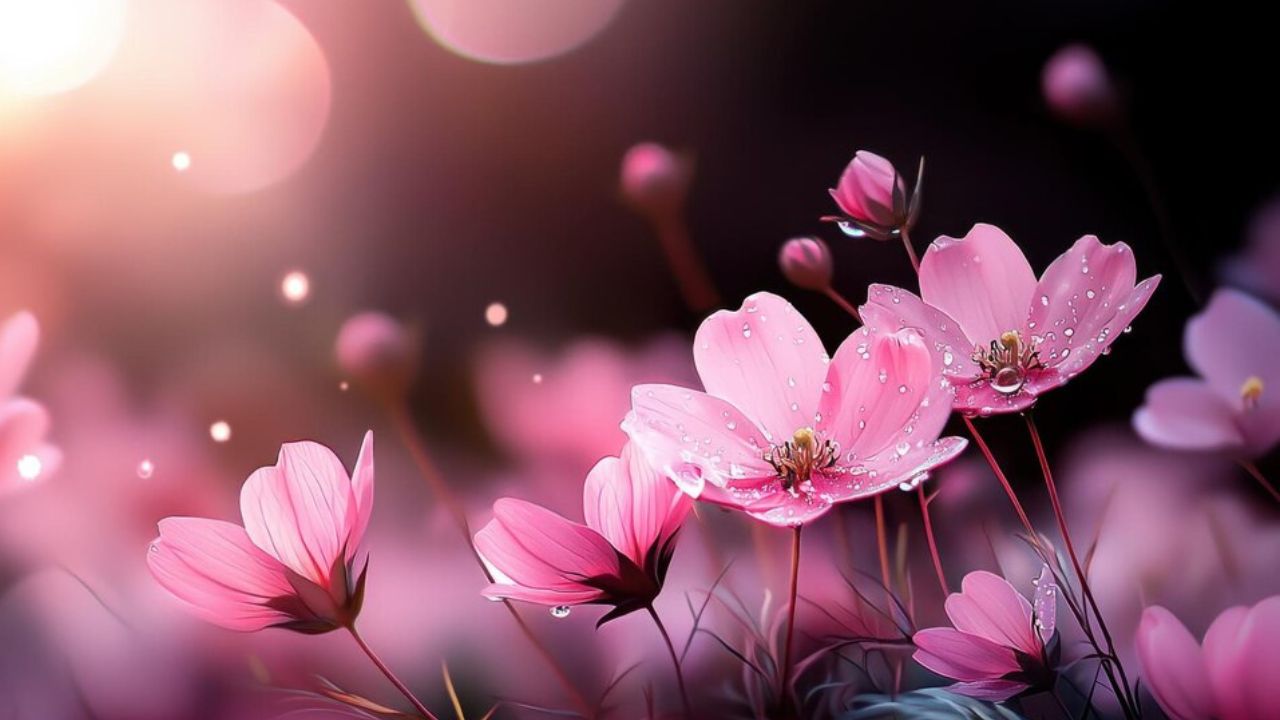Natural Beauty
Desert Oasis Wonders: Nature’s Hidden Jewels

You may picture enormous lengths of desolate sand when you think of a Desert Oasis Wonders along with intense heat, dry scenery, and a strong sensation of loneliness. Oases, which are isolated areas of beauty and vitality within these harsh surroundings.It provide a striking contrast. These oases in the desert are not just places to get water. They are amazing natural beauties that support a variety of ecosystems and provide essential sustenance for both people and wildlife. Let us explore the fascinating world of desert oases and learn about the treasures they have to offer.
What Exactly is a Desert Oasis?
When subterranean rivers or aquifers bring water to the surface in a dry area, they create a Desert Oasis Wonders. These regions often form tiny lakes and springs, turning barren land into life-sustaining environments. The presence of water converts a barren desert into a lively paradise by fostering the growth of plants, animals, and even human settlements.
The Role of Oases in Desert Ecosystems
Oases are essential to the ecology of the desert. They offer much-needed water and shade, acting as havens for a variety of animals. Palm trees, date palms, and other plants thrive around these water sources, forming microhabitats. An oasis provides a safe refuge for insects, birds, and larger mammals in the harsh desert environment.
Famous Oases Around the World
You can find oases in deserts all over the world, with some of the most well-known located in North Africa and the Middle East.Here are a few well-known instances:
Siwa Oasis, Egypt: Siwa Oasis, well-known for its breathtaking palm trees and lengthy history, has long served as a crossroads for trade and culture.
Huacachina, Peru: Huacachina is a vibrant, scenic desert oasis that draws travelers with its beauty and unique location. It is tucked away among undulating sand dunes.
Al-Ahsa Oasis, Saudi Arabia: One of the biggest oases on Earth, this UNESCO World Heritage site is home to millions of date palms and a rich cultural past.
Oases as Lifelines for Ancient Civilizations
Oases were essential to the growth of trade networks and civilizations in antiquity. These locations served as rest stops and sources of water for caravans traversing huge deserts. These oasis developed into centers of trade and culture that promoted the sharing of products, concepts, and customs.
The Threats to Modern Oases
Threats to today’s oases include over-extraction of water, human encroachment, and climate change. It gets harder to keep these ecosystems in their delicate balance as deserts grow larger as a result of rising global temperatures. Preserving the history they hold and maintaining biodiversity depend on these natural riches being protected.
Conclusion
More than just water in the middle of a desert, oasis provide much more. These are dynamic ecosystems full of life and history that provide a peaceful respite from the roughness of the surrounding area. These marvels of nature serve as a constant reminder that life persists, even in the most unlikely of locations.
FAQs
What is a desert oasis?
A desert oasis is a productive region where water spontaneously rises to the surface, fostering the growth of vegetation, animals, and occasionally even human settlements.
How do oases form in deserts?
Oases form when underground water sources, such as springs or aquifers, rise to the surface, delivering water to otherwise dry and barren areas. This flow of water transforms desolate landscapes, enabling life to thrive in the harsh desert environment.
What types of plants grow in oases?
Date palms, grasses, and other desert-adapted flora that can flourish close to water sources are common plants found in oasis.
Why are oases important for wildlife?
Oases are essential for desert survival since they give a variety of desert creatures food, drink, and refuge.
Are oases disappearing?
Climate change and excessive water extraction are two major dangers to many oases, which can cause them to degrade and lose biodiversity.
Natural Beauty
The Beauty Beyond Blooms: Nature’s Hidden Wonders

It is simple to envision vivid The Beauty Beyond Blooms with their alluring hues and delicate petals, when we consider the beauty of nature. Flowers are indeed beautiful, but there is so much more to nature than these arrangements of flowers. Beyond flowers, the natural world’s beauty emerges in minute, often overlooked aspects that reveal the diversity, resilience, and harmony of life.
The Silent Symphony of Leaves
Beyond flowers, plants’ leaves are a major component of the subdued beauty of the blooms. Leaves have a certain allure, whether they are covered in dew from the morning or fluttering in the breeze. Every leaf is different, with complex vein patterns that resemble tiny road maps. If you take the time to examine a leaf in great detail, you will see how its structure reflects the meticulousness of nature.
The sizes and shapes of leaves on different plant species vary, from the broad, glossy leaves of tropical plants to the thin, needle-like leaves of evergreens. Autumn’s fiery reds, oranges, and yellows gradually replace the brilliant greens of spring and summer, producing a seasonal display that rivals any flower bed.
The Fascinating World of Fungi
Fungi are among nature’s most underappreciated treasures, frequently hiding in tree shadows or under the forest floor. The observable portions of these organisms are not limited to mushrooms, exhibiting wide array of shapes and colors. A massive network of mycelium extends below the surface of the earth, silently decomposing organic debris and contributing significantly to the ecology.
Fungi are beautiful because of their function as well as their outward look. They are the recyclers of nature, turning animal and plant remains into nutrients that encourage the growth of new life. Fungi serve as a reminder that beauty and rebirth can exist even in decay.
The Whisper of Wind and Water
The sounds of nature can uplift the spirit, even though blooms may capture the sight. The wind rustling through the trees, the soft lap of waves against the shore, and the bubbling of a stream over smooth stones produce a natural soundtrack that relaxes and calms.Even though these noises are frequently faint, they serve as a reminder of life’s ever-present motion and flow.
Particularly, water is a source of both life and beauty. Water has a dynamic yet serene beauty, whether it is in the quiet of a lake reflecting the sky or in the might of a cascade smashing through rocks. Its existence sustains all types of environments, including dry deserts and lush forests.
The Art of Stones and Soil
Even the ground beneath our feet has a narrative to tell about beauty and transformation, even though it may not be immediately apparent. In addition to providing habitats for plants and animals, soil, stones, and pebbles all contribute to the formation of the landscape and the preservation of Earth’s historical records.
Time and the elements have worn rocks into exquisite textures and patterns. They offer dimension to the fabric of nature with their variety of hues and shapes, which range from smooth river stones to jagged cliffs. Though sometimes overlooked, soil is brimming with life below the surface, with innumerable species cooperating to maintain the ecosystem.
The Resilience of Life
The resiliency of nature is arguably one of its most exquisite features. Even in the most hostile settings, such as mountain tops and deserts, life manages to survive. The sight of a single plant pushing through a crack in the sidewalk or a tree standing tall after a storm demonstrates nature’s resilience.This tenacity serves as a reminder that beauty is about more than simply aesthetics—it is also about fortitude, adaptability, and survival.
Conclusion
There is no denying the beauty of blooms yet there is much more to nature than meets the eye. It is there in the minute details of leaves, the silent labor of mushrooms, the calming sounds of water and wind, and the tenacity of life on Earth. We may strengthen our bond with nature and cultivate a deeper feeling of awe and respect for the surroundings by taking the time to appreciate these frequently disregarded components of the natural world.
FAQs
What does “beauty beyond blooms” mean?
It alludes to the inherent beauty of things found in nature other than flowers, such fungus, leaves, rocks, and the sounds of the wind and water.
Why are leaves considered beautiful in nature?
People highly prize the distinct forms, hues, and patterns of leaves, especially when they display nature’s intricate designs as they change with the seasons.
What role do fungi play in nature?
Like mushrooms, fungi are organic matter’s recyclers in the wild, breaking down dead materials and improving the soil to make place for new plant life.
How can water be beautiful in nature?
Whether it takes the shape of a serene lake, a meandering stream, or a mighty cascade, water is dynamic and serene, providing both a visual and aural link to the natural world.
Why is resilience considered beautiful in nature?
Water is dynamic and peaceful, offering a visual and auditory connection to the natural world, whether it takes the form of a placid lake, a winding stream, or a powerful waterfall.
-

 Celebrity12 months ago
Celebrity12 months agoJulia Rejean Moorhead: A Trailblazer in Her Field
-

 News12 months ago
News12 months agoThe Ever-Evolving World of News:Global Events Unfolding Today
-

 INFORMATION12 months ago
INFORMATION12 months agoUnderstanding Information: Its Role and Impact in Our Lives
-

 Sports12 months ago
Sports12 months agoGonzaga Basketball: The Rise of a College Hoops Powerhouse
-

 Sports12 months ago
Sports12 months agoThe Incredible Benefits of Sports: Boost Your Life on All Fronts
-

 Business12 months ago
Business12 months agoRogue Trader Rotate Grand Strategist:The Dynamic World of Trading
-

 Technology9 months ago
Technology9 months agoFascinating Facts About Astronauts:The Ultimate Guide
-

 Health12 months ago
Health12 months agoThe Ultimate Guide to Health: Tips and Strategies for a Healthier
